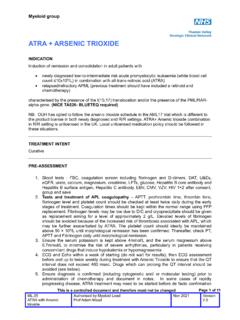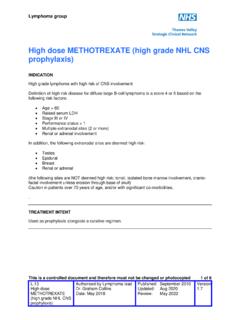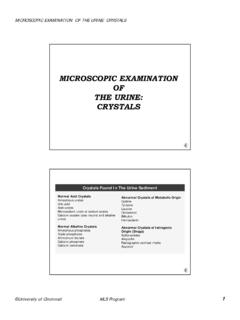Transcription of Management of the Prevention and Treatment of Tumour …
1 Department of Clinical Haematology Page 1 of 7 December 2021 Tumour Lysis Syndrome Authorised by: Dr Andy Peniket This is a controlled document and therefore must not be changed Management of the Prevention and Treatment of Tumour Lysis Syndrome in Adults Background Tumour Lysis Syndrome (TLS) is a metabolic complication that can occur during chemotherapy, or radiotherapy, for certain haematological malignancies and very occasionally solid tumours. TLS is characterised by the rapid development of two or more of the following: Hyperuricaemia Hyperkalaemia Hyperphosphataemia Hypocalcaemia Clinical TLS (laboratory TLS with one or more of the following clinical manifestations: acute kidney injury (rising creatinine), cardiac arrhythmia, seizure or sudden death. The acute release of intracellular products ( urate, phosphate, potassium) into the circulation is a result of lysis of radiosensitive or chemosensitive rapidly proliferating cells.)
2 Hypocalcaemia occurs as result of precipitation of calcium phosphate in soft tissues due to the acute development of hyperphosphataemia. Acute renal insufficiency results from the precipitation of uric acid (common pre- chemotherapy) and/or calcium phosphate crystals in renal tubules (common following chemotherapy). Risk Factors There are several well recognised risk factors for the development of laboratory and clinical TLS, including: 1. High Tumour burden 2. High grade tumours with rapid cell turnover 3. Pre-existing renal impairment or renal involvement by Tumour 4. Increased age 5. Treatment with highly active, cell-cycle specific agents 6. Concomitant use of drugs that increase uric acid levels, for example: alcohol, ascorbic acid, aspirin, caffeine, cisplatin, diazoxide, thiazide diuretics, adrenaline (epinephrine), ethambutol, levodopa, methyldopa, nicotinic acid, pyrazinamide, phenothiazines and theophylline Definition Evidence of laboratory Tumour lysis syndrome is defined as two or more of the following (Cairo & Bishop, 2004): uric acid* 476 micromol/l or 25% increase from baseline potassium* 6mmol/l or 25% increase from baseline Calcium or 25% decrease from baseline phosphate* mmol/l or 25% increase from baseline Additional Investigations LDH: elevated Serum creatinine > times the upper limit Serum urea: elevated Urine PH: <5 ECG: arrhythmia Department of Clinical Haematology Page 2 of 7 December 2021 Tumour Lysis Syndrome Authorised by.
3 Dr Andy Peniket This is a controlled document and therefore must not be changed Risk Stratification for TLS Risk stratification enables the identification of patients that should be offered active monitoring, hydration and rasburicase prophylaxis, as opposed to the low and intermediate risk groups, in which hydration +/- allopurinol prophylaxis should suffice (perhaps with inpatient monitoring in borderline situations). High-risk patients can be identified by the following criteria: Burkitt s or Burkitt s-like Lymphoma Lymphoblastic Lymphoma ALL WCC > 100 x 109/l AML WCC > 100 x 109/l CML in blast crisis WCC > 100 x 109/l Or WCC < 100 and LDH >2 times upper limit of normal High-grade Lymphoma with bulky disease defined by LDH more than twice the upper limit of normal or Tumour bulk >10 cm in diameter Note: Diseases which are traditionally low risk ( CLL) may become very high risk with the use of novel therapeutics. Special care should be taken in these therapy-specific circumstances, irrespectively of pathology.
4 Increasing age, pre-existing renal impairment and renal involvement by tumor are also factors which increase risk and may push the treating clinician to consider specific patients as high-risk. Prevention of Tumour Lysis Syndrome 1. Low/Intermediate Risk Patients (prophylaxis) Low/intermediate risk patients can be managed with a combination of hydration and allopurinol Hydration Start hydration before anti-cancer Treatment . Aim for total hydration fluid of 2-3 litres/24 hours AVOID additional potassium in hydration fluids Medication Allopurinol 300mg ONCE daily for 7 daysa, start 24-48 hours prior to anti-cancer Treatment . Reduce allopurinol to 100-200mg ONCE daily where creatinine clearance (CrCl) is <20ml/min. a This dosing follows standard and established practice within haematology; however, the adult dosing schedule allows 200 400 mg/m2/day in 1 3 divided doses, up to a maximum of 800 mg daily. Observations: Daily weight, vital signs, fluid balance, blood sampling (creatinine, urea & electrolytes; including calcium, phosphate, potassium and magnesium, uric acid, LDH) in addition to usual anti-cancer Treatment monitoring Additional considerations: Minimise use of concurrent nephrotoxic drugs, avoid thiazide or potassium-sparing diuretics A select group of intermediate-risk group patients may warrant inpatient monitoring with enhanced hydration and electrolyte monitoring Patients allergic to allopurinol should be considered for rasburicase Department of Clinical Haematology Page 3 of 7 December 2021 Tumour Lysis Syndrome Authorised by: Dr Andy Peniket This is a controlled document and therefore must not be changed Deterioration during prophylactic Treatment In the case of deteriorating biochemical, or clinical markers, there should be prompt switch to rasburicase (where not contra-indicated).
5 In individuals contra-indicated for rasburicase, allopurinol doses can be increased up to a maximum of 800mg/day (in 2-3 divided doses). 2. High-Risk Patients (prophylaxis) High risk patients should be managed with a combination of hydration and rasburicase. Hydration Hydration should start 2 days before anti-cancer Treatment Administer IV fluids to maintain urine output of 100ml/m2/hour Consider loop diuretic to force diuresis if not adequate AVOID additional potassium in hydration fluids Medication Rasburicase IV ONCE 30-60mins prior to anti-cancer Treatment . A second dose can be considered within individual cases. In G6PD deficient individuals: Allopurinol 200 400mg/m2/day in 1-3 divided doses, up to a maximum of 800mg daily Rasburicase prophylactic dosing The licensed dose is IV for up to 7 days (Sanofi, 2021), however a meta-analysis reviewing the effectiveness of a single fixed dose of rasburicase in high-risk patients concluded non-inferior clinical benefit to the licensed dose for high-risk prophylaxis (Feng et al, 2013).
6 Within local audit the fixed dosing has been found to be safe and effective (Cheung et al, 2021). The recommendation for this dose differs to the fixed dosage of 3mg suggested by BSH guidance (Jones et al, 2015); the evidence supporting a move from to an even lower prophylactic dose is not yet convincing at this moment in time. Taking this into account, a single, fixed dose of mg rasburicase for high-risk patients is recommended prior to chemotherapy, with regular monitoring and application of a second dose if required. Observations: Daily weight, vital signs, fluid balance, blood sampling (creatinine, urea & electrolytes; including calcium, phosphate, potassium and magnesium, uric acid, LDH) in addition to usual anti-cancer Treatment monitoring Additional considerations: Minimise use of concurrent nephrotoxic drugs, avoid thiazide or potassium-sparing diuretics A number of contra-indications to rasburicase Treatment exist, please refer to Appendix 1 Deterioration during prophylactic Treatment In the case of deteriorating biochemical, or clinical markers, there should be prompt escalation to the full protocol for Management of established TLS.
7 Department of Clinical Haematology Page 4 of 7 December 2021 Tumour Lysis Syndrome Authorised by: Dr Andy Peniket This is a controlled document and therefore must not be changed Protocol for the Management of Established Tumour Lysis Syndrome 1. Liaise with ITU/ renal unit as early as possible 2. Hydration Ensure IV fluids are running at greater than 3 litres/m /day ( twice usual maintenance) It is critical that potassium is NOT added to the hydration fluid Aim for urine output greater than 100ml/ m / hr. Monitor urine output hourly Consider loop diuretic to force diuresis if not adequate Biochemistry every 6 hours or the first 24 hours after diagnosis Maintain strict fluid balance chart and place urinary catheter Assess fluid balance formally every 4 hours Weigh twice daily Fluid retention may be treated with IV furosemide ( 1mg/kg) or mannitol ( ) if weight gain is > 3 kg. In the event of severe oliguria or anuria, a single dose of furosemide (2-4mg/kg) may be considered to improve or initiate urinary output 3.
8 Rasburicase Initiate rasburicase at mg/kg IV for 3-7 days depending on clinical and biochemical parameters: No dose adjustment is necessary in renal or hepatic impairment. Where rasburicase is contra-indicated, ensure maximum dose of allopurinol is administered (up to max 800mg daily in 2-3 divided doses). Refer to Appendix 1 for contra-indication, side-effects, reconstitution and administration details 4. Patient Monitoring A patient with established TLS can deteriorate rapidly, and close monitoring is essential to anticipate escalations in care. Clinical monitoring o Vital sign monitoring (SaO2, RR, HR, BP and T) at least 4 to 6-hrly o Urine output monitoring on an hourly basis o Weight, at least daily o Clinical examination of fluid status at least 6-hrly o ECG monitoring at baseline, and as indicated (see Hyperkalaemia and Hypocalcemia sections below) Blood monitoring o Check potassium, phosphate, calcium, magnesium, urea, creatinine and urate at least 6-hrly initially, using blood gas samples in parallel to acquire rapid potassium values o Blood sample Management and Rasburicase: in patients who have received Rasburicase, uric acid levels continue to drop in vitro and so results will be spuriously low, making interpretation difficult.
9 This effect can be mitigated, though not completely avoided, by immediately placing the sample on ice and rushing it to the biochemistry laboratory for rapid assay. This may not be feasible in day-to-day practice, in which case the biochemical and clinical picture should be taken in its entirety to guide Management . If there is no evidence of TLS reduce frequency of sampling Department of Clinical Haematology Page 5 of 7 December 2021 Tumour Lysis Syndrome Authorised by: Dr Andy Peniket This is a controlled document and therefore must not be changed 5. Treatment of hyperkalaemia Clinical manifestations include: nausea, anorexia, vomiting, diarrhoea, neuromuscular and cardiac abnormalities Treat according to local guideline for Management of hyperkalemia The current OUH guideline can be accessed on the Medicines Information Leaflets (MILs) directory on the intranet- Management of Hyperkalaemia in Adults Information re ECG monitoring etc.
10 Is contained within the OUH link immediately above, print out the document for pathway Management . 6. Treatment of hyperphosphataemia Clinical manifestations include: nausea, vomiting, diarrhoea, lethargy and seizures If hydration and timely administration of rasburicase do not prevent significant hyperphosphataemia, it can be hard to control phosphate levels other than by dialysis. The temporary use of aluminum hydroxide 50 150 mg/kg/day has been described but is slow to act and poorly tolerated, thus is not routinely recommended in this setting Avoid calcium supplements except in neuromuscular irritability 7. Treatment of hypocalcaemia Clinical manifestations include: muscular (cramps and spasms, paraesthesias, tetany), cardiovascular (ventricular arrhythmias, heart block, hypotension, prolonged QT interval) and neurological complications (confusion, delirium, hallucinations and seizures) Treatment of asymptomatic hypocalcaemia is generally not recommended as the risk of precipitating metastatic calcification is high, especially in the setting of hyperphosphataemia Symptomatic hypocalcaemia should be treated with IV calcium gluconate as per local guideline.













